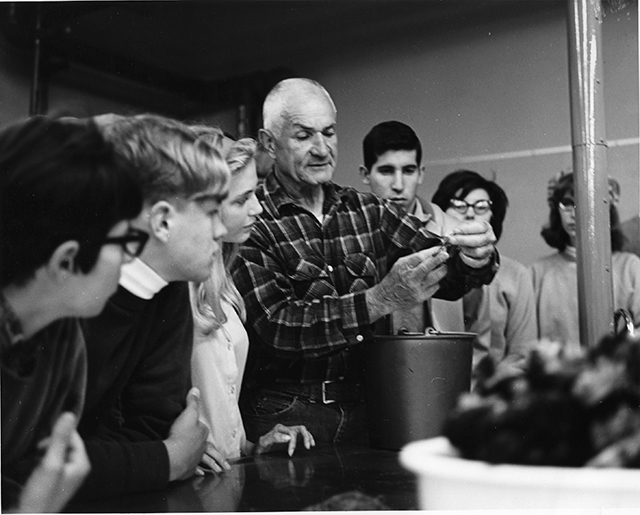
Fifty years later – amid alarming reports about overfishing and climate change – the Telonicher Marine Laboratory is an important resource for scientists and students, and for conducting research on a relatively unstudied stretch of California Coastline.
A long-established part of Humboldt State’s Marine Sciences program, the lab celebrated its 50th anniversary on September 18. It has undergone changes over the years, but retains the nurturing charm that has engaged students and faculty for five decades.
PHOTO GALLERY: a look back at the lab
The lab’s many resources include a system that recirculates seawater and provides access to state-of-the-art technical equipment to a fleet of small boats. Scientists also have access to a research vessel, the Coral Sea, and a remotely operated underwater vehicle that was donated by the U.S. Navy.
“The oceans are currently challenged with tremendous pressures from human activities,” says current lab director and Marine Biology Professor Brian Tissot. “The marine lab represents a significant investment in facilities and technology that can help focus on these important regional, state, and national issues.”
Fred Telonicher: Renaissance Man
Though no one’s quite sure who came up with the idea to build a lab, longtime HSU professor Fred Telonicher—along with Wildlife Management Professor William Lanphere and Harrie D. MacGinitie, a Physical Science professor—are credited with helping to conceptualize and plan the lab, according to former lab director (1979 to 1984) John DeMartini (’55 Life Science and General Science).
Often described as a Renaissance man, Telonicher was an HSU football coach who became a zoology professor, teaching virtually all zoology courses during his 40 years at HSU, says DeMartini.
“Telonicher explained things well. He was rigorous and he was tough. Everyone had a lot of respect for him,” he recalls. He took most of Telonicher’s courses and considers him his mentor.
Today, the 16,000 square foot facility bustles with research projects, classes and, of course, a variety of marine life—some of which are on display for the 20,000 visitors the lab receives each year.
“Fifty years is a long time for a marine lab,” says Tissot. “What’s remarkable about this lab is how much the students, staff, and faculty really love this place.”
When it comes to access—geographically, scientifically and educationally—there’s certainly much to love. Tissot points out that HSU’s lab is close not only to campus, but also diverse marine habitats and geological formations such as sandy beaches, lagoons, protected and exposed subtidal areas, and offshore submarine canyons.
“When I teach, my students and I literally just walk right down to the shore, grab samples, come back up and put them under a microscope,” says Tissot.
Beyond ‘Learning from a Jar’
Collecting samples highlights the lab’s mission of giving students practical experience. Nowhere is this more evident than in the culture room. There, various types of algae and brine shrimp are grown and maintained by student technicians.
“I had a chance to help with different projects and professors. Doing that gives you first hand experience, which made me fall in love with the lab,” says former technician Paige Weiss (’16 Marine Biology). She’s now employed by the lab as the Marine Naturalist, giving tours and educating students and the public about the lab and its animals. “It’s better to catch animals and study them live rather than learning from a jar.”
Working alongside and mentoring students are professionals like Eric Bjorkstedt, a scientist with the National Oceanic and Atmospheric Administration (NOAA) and an adjunct professor in Fisheries Biology at the University.
“I came to Humboldt because NOAA wanted to have a scientist here to conduct ocean observing and research off the coast, make use of the Coral Sea, and collaborate with HSU marine science programs,” says Bjorkstedt.
One of these collaborative research projects examines the effects of ocean acidification and hypoxia—consequences of climate change—on juvenile rockfish.
It’s a project made possible by a major renovation of the wet lab in 2010-2011, the largest since 1974. Funded through a $200,000 National Science Foundation grant, alumni contributions, and private donations, the recent overhaul included new digital displays highlighting local marine life and enhanced classroom facilities, plus a new plumbing system that makes it easier for students to alter the temperature and salinity of water.
What hasn’t changed is the lab’s importance to the students and to the unique research being conducted.
“We’re the only university on the North Coast, which puts us in a special position,” says Tissot. “We teach our students about the biology, chemistry, geology, and physics of the ocean so they can apply what they’ve learned to the real world and offer something really unique to the state and to the nation. “